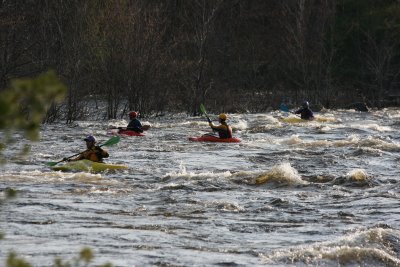Posted: August 4, 2014
The Petawawa River: to Dam or not to Dam

Xeneca Power Development has presented their updated plan on the Big Eddy Project, a proposed hydroelectric generating station on the Petawawa River. We are still not in favour of damming one of the last free flowing tributaries of the Ottawa River.
On August 7th, 2012 Xeneca Power Development Inc presented their updated plan on the Big Eddy Project, a proposed hydroelectric generating station on the Petawawa River.
The project is one of two run-of-the-river hydro dams Xeneca is seeking to build on the Petawawa. The Big Eddy would be located approximately 2 km from where the Petawawa River drains into the Ottawa River, just above the town of Petawawa. The other project, Half Mile Rapids, would involve a second generating station another 7 km upriver from the Big Eddy station.
When Xeneca released their initial design plans in the spring of 2011, we at Ottawa Riverkeeper had serious concerns about the impact of the project on the Petawawa River and river users, so we submitted recommendations to Xeneca.
What is Run-of-the-River Hydro?
‘Run-of-the-river’ hydroelectric generating stations store little, or no, water but still require a dam. Run-of-the-river stations generate electricity by diverting the natural flow of the river through piping onto turbines. Run-of-the-river dams, then, can be much smaller than traditional hydro dams, since their main function to divert, rather than store, water. However, run-of-the-river systems still have a profound impact on a river’s flow regime, they reduce biodiversity, and they create migration barriers to fish and other animals.
Problems with the Big Eddy Proposal
There are only two remaining undammed tributaries of the Ottawa River: the Petawawa River and the Dumoine River in Quebec. In other words, these are the only tributaries of the Ottawa River whose flow rate and water levels fluctuate with natural daily, seasonal and multiyear cycles. Changing a waterway from an unmanaged to a ‘managed’ waterway – where water levels and flows are controlled on a schedule set by the hydroelectric company – can have a profound effect on the river’s health and its recreational value, so must be very carefully considered.
A few of the issues that concerned us with Xeneca Power’s initial proposal are as follows.
1. How will fish migrate up and down stream?
In the original Xeneca plan, there was no fish ladder. Both muskellunge and sturgeon are known to spawn in the Petawawa River, and the river is one of the last safe tributaries for migrating American eel, an endangered species whose survival is dependent on ‘safe passage’ up, and especially down, the river, as the large females return to the Sargasso Sea to spawn. With no fish ladder in place, fish migrating up or down the Petawawa will either be blocked from migrating, or will be sliced to pieces as they swim through the turbines.
2. What impact will reduced river flows have on recreation and river ecology?
According to Xeneca, river flows will be reduced by up to 80% during peak hours. This precipitous drop in both water levels and flow rate will make boating, fishing and swimming unpleasant or impossible. The unnatural flow patterns may also damage fish and vegetation, as well as causing shoreline erosion.
The timing of water releases is also an issue of concern, especially for people in kayaks and canoes. In the most recent information we’ve received from Xeneca, the company says that their new design incorporates a rock weir. “The rock weir,” the newsletter states, “is designed to allow kayak passage during high flows and during hours when flow is being provided for kayak recreation.”
There is no indication of when and for how long Xeneca is willing to share the river with kayaks and canoes.
3. Will the public have access to the shoreline and river?
The Petawawa River is a navigable waterway used by thousands of people per year. In Canada, navigable waterways are legally public resources and access should not be restricted. Under the water-flow regime proposed in the first-draft design, water levels downstream would be reduced for large parts of the day, rendering the river un-navigable. Even in those sections of the river that would still be navigable, the drastically diminished flows would lower the recreational opportunities for the river.
4. Do the potential benefits outweigh the damage?
The Big Eddy generating station will generate just over 5 MW of electricity. While Ottawa Riverkeeper applauds any move to greener energy solutions, in the case of the Big Eddy project, we question the financial and environmental gain when balanced against the loss of tourism, recreation and aquatic and shoreline habitat. It would, in fact, take 750 ‘Big Eddy Projects’ to replace the over 4000 MW generated by the coal-fired Nanticoke power plant.
Riverkeeper Recommendations
In May 2011, we made the following recommendations in a submission to Xeneca Corp.
1. Before any dams are approved on the Petawawa River, all local interests and stakeholders should come together to create a Petawawa River Watershed Management Plan. Such a plan was developed successfully for the Madawaska River and finalized and signed in 2010.
2. No dams should be approved on the Petawawa River if Xeneca Power Development Corp cannot provide:
a. A dam that guarantees safe upstream and downstream passage for the American eel and other migratory species;
b. A plan to manage instream flow conditions to meet the needs of the species that live in and near the river as well as the needs of the local paddling and fishing community;
c. Proof that the value of the electricity generated from the proposed facility is greater than the value of a healthy, intact river system with respect to cumulative socio-economic benefits from fishing, recreation, tourism and cultural heritage.
< Previous post Next post >